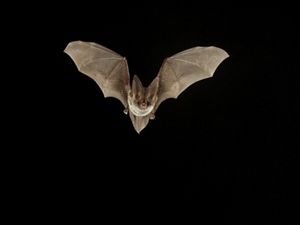The Mojave Desert is a national treasure. Its otherworldly beauty shelters a huge range of unique plants and animals, and its 20 million acres provide for people in a multitude of ways: clean water to drink, fresh air to breathe, energy to power our lives, and economic opportunities from recreation to military training.
The Nature Conservancy is working to protect this beautiful, irreplaceable desert habitat. Browse these photos for a peek at 12 native species we're working to protect that share the desert with Las Vegas.
Bighorn Sheep
OVIS CANADENSIS NELSON
FAST FACTS - Found in the southwestern U.S. and northern Mexico - Weighs up to 300 lbs. - Lives 10 to 20 years - Found in herds of 8 to 10 individuals
DID YOU KNOW? These agile animals are well adapted to Nevada’s dry environment, going several weeks without water while living mostly off grasses and, sometimes, cacti. The bighorns' concave hooves allow them to climb steep, rocky desert mountains quickly and easily, helping them escape predators such as mountain lions, coyotes and bobcats. Both male and female sheep grow their signature horns shortly after birth, and their horns continue growing throughout their lifetimes. Ewes have smaller lighter horns that rarely grow larger than a half-curl. Older rams can have impressively curled horns measuring over three feet long and weighing as much as 30 pounds. Rams are known for head-to-head battles that can last as long as 24 hours. The total population of desert bighorns is estimated to be about 13,000; some of the biggest threats they face are disease from livestock and loss of habitat.
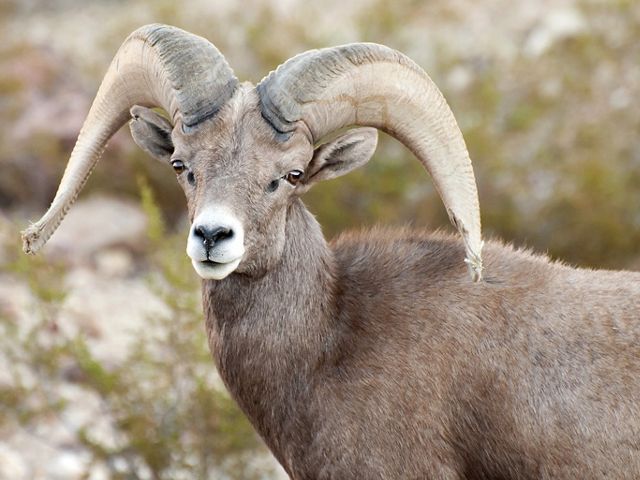
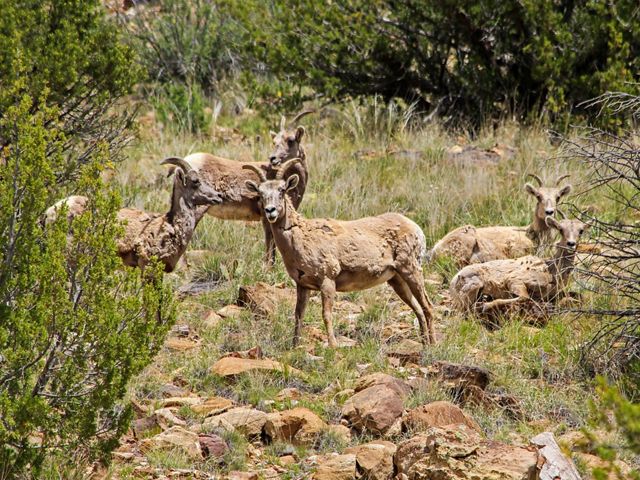
Greater Roadrunner
GEOCOCCYX CALIFORNIANUS
FAST FACTS - Found in the Mojave and Sonoran deserts - Grows 18 to 24 inches tall - Lives 7 to 8 years - Eats insects, rodents, birds and rattlesnakes
DID YOU KNOW? This quirky looking bird—with its tufted feather crest, long legs and zippy demeanor—is the largest member of the diverse cuckoo family. And it's a fearless predator that feasts on rodents, bats, other birds and even poisonous prey like scorpions and rattlesnakes. Greater roadrunners are well suited for the desert since they can lower their body temperatures at night and warm up in the morning by spreading their wings to expose their dark skin to the sun. This temperature regulation helps them conserve the energy they need for running down prey. They can fly short distances if they want to, but seem to prefer running. Greater roadrunners are also known for being flirtatious, with courtship rituals that include offers of twigs or food. When they mate, it is often for life.
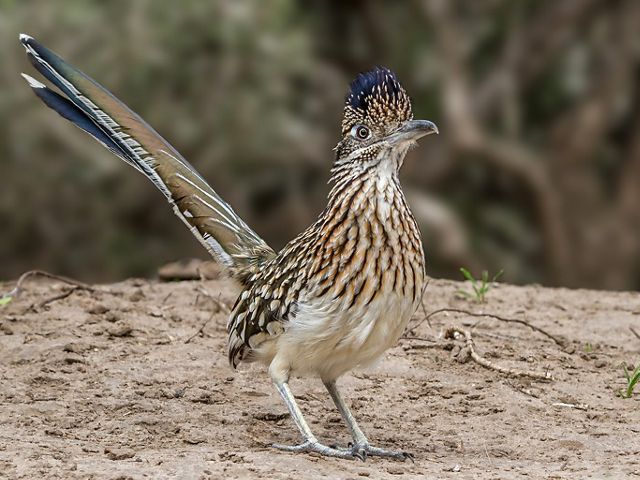
Desert Pupfish
CYPRINODON MACULARIUS
FAST FACTS - Found in desert pools, streams and springs - Grows up to 3 inches long - Lives 6 to 9 months - Eats aquatic insects and algae
DID YOU KNOW? This tiny fish tolerates warm, salty water. When water temperatures cool each winter, they can burrow into their underwater home’s muddy bottom to survive, feeding mostly on green and brown algae. Mating season for pupfish starts in February and runs through the summer. During mating, male pupfish become iridescent blue and fiercely defend their territorty, chasing away everything except females ready to spawn. The various species of pupfish offer evidence that the now disconnected desert lakes were once a single, interconnected lake. When the lake evaporated some 10,000 years ago, the pupfish were isolated in the remaining desert pools. Several species of pupfish are endangered due in large part to habitat loss and threats from non-native fish that have been introduced into their habitats.
Burrowing Owls
ATHENE CUNICULARIA
FAST FACTS - Found in the western U.S., Mexico and South America - Grows 8 to 10 inches tall - Lives 6 to 8 years - Eats large insects and small mammals
DID YOU KNOW? They are one of the smallest owls in North America and different from most owls in several ways. Burrowing owls nest under ground instead of in trees. They are not exclusively nocturnal; they hunt around the clock, often eating insects by day and catching small mammals at night. They have unusually long legs and spend much of their time on the ground. They also lack tufts of feathers just above their eyes like most owls. While burrowing owls can dig their own nests if necessary, more often they will occupy a hole that has been abandoned by a prairie dog, badger, desert tortoise or other small creature. When building a nest, they often surround it with animal waste to attract dung beetles. This ensures that one of the intelligent bird's favorite foods will be nearby at all times!
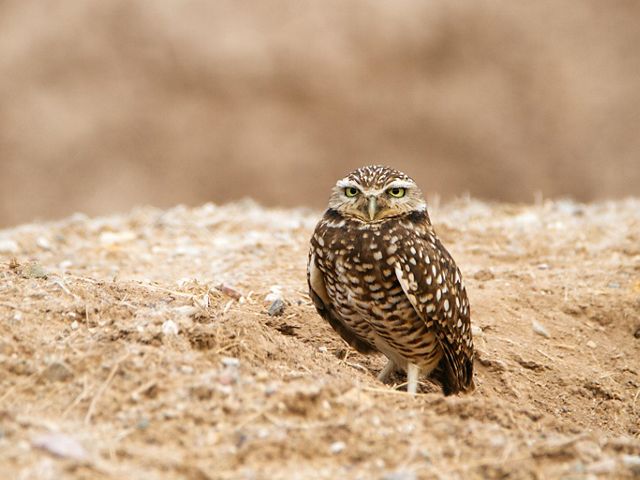
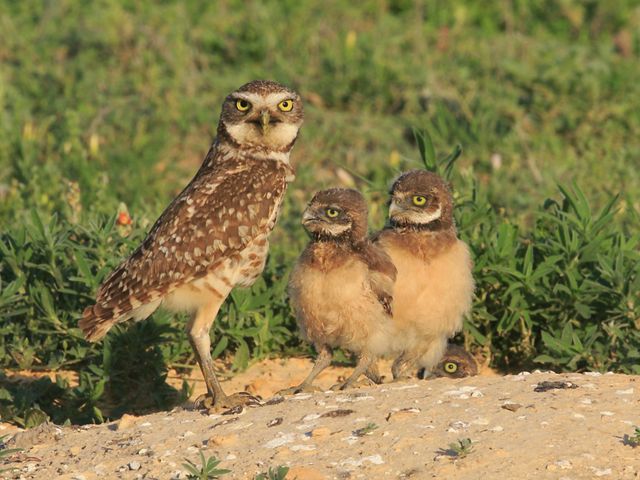
Mountain Lion
PUMA CONCOLOR
FAST FACTS - Found in western North America - Weighs up to 180 lbs. - Grows up to 2 ½ feet tall - Lives 8 to 13 years
DID YOU KNOW? The mountain lion is known by many names, such as cougar, puma, panther and catamount. While it is among the largest cats in the world, it is more closely related to smaller felines (including domestic cats) than to lions or tigers. In fact, it is not classified as one of the “big cats” because it doesn’t have the type of voice box that would enable it to roar. However, mountain lions are well-known for their screams and they make other sounds similar to those of house cats—just a lot deeper and louder. Most of the time mountain lions are quiet and solitary. They come out to hunt at dawn or dusk and try to avoid people. They may occupy from 30 to 500 square miles (males roam further) when not limited by humans or other large predators such as grizzlies or wolves. Females are fiercely protective of their cubs, who may stay with their mothers for up to two years.
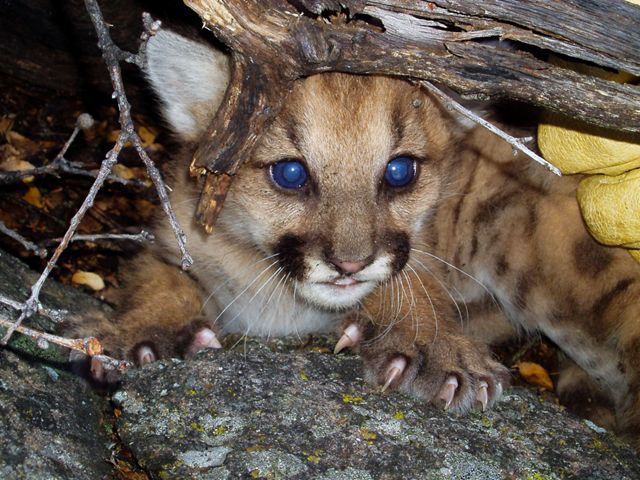
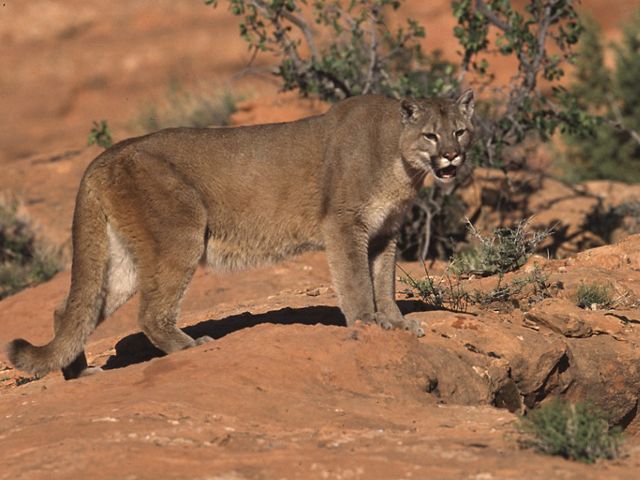
Jackrabbit
LEPUS CALIFORNICUS
FAST FACTS
- Found in the western U.S. and Mexico
- Grows up to 2 feet long
- Lives 2 to 5 years
- Eats shrubs, grasses and flowers
The black-tailed jackrabbit is actually not a rabbit at all—it is a hare. Known as the American desert hare, settlers in the western U.S. called it a “jackass rabbit” because its enormous ears look like those of a donkey. Eventually the name was shortened to jackrabbit. While they may look odd, those large ears are extraordinarily useful, helping hares to detect threats from far away and dissipating heat when the temperature rises. Black-tailed jackrabbits also have powerful hind legs; they can leap up to 10 feet and run up to 40 miles per hour, zigzagging to avoid predators (they have many). Baby black-tailed jackrabbits are born fully furred with their eyes wide open (unlike rabbits) and they are almost immediately mobile. Mothers do not protect or even stay with their young except during nursing, but the young are well-camouflaged among shrubbery and grasses. Litters will typically stick together for about a week after being weaned.
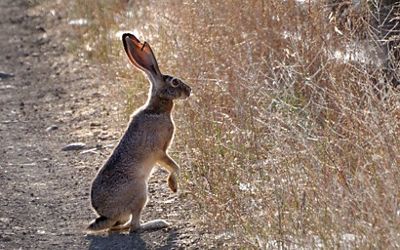
Joshua Tree
YUCCA BREVIFOLIA
FAST FACTS
- Found in the Mojave Desert
- Lives for more than 150 years
- Grows up to 50 feet tall
DID YOU KNOW? The largest yucca, Joshua trees were the preferred food of the extinct giant ground sloth that lived in the Las Vegas Valley 32,000 years ago. Joshua trees grow quickly for a desert plant; they can grow an average of three inches each year for the first decade. They develop deep, extensive root systems that can stretch as much as 36 feet away from their trunks. Joshua trees don't bloom every year: They need rainfall at the proper time and a winter freeze before they will bloom. Scientists predict that the Joshua tree's range will be reduced as the climate continues to change.
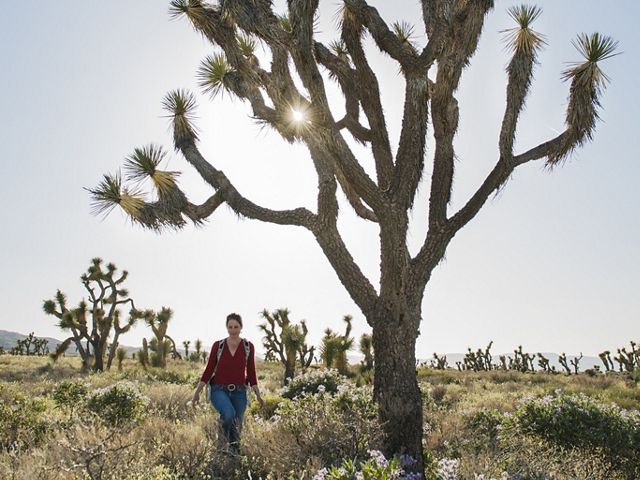
Giant Desert Hairy Scorpion
HADRURUS ARIZONENSIS
FAST FACTS
- Found in the southwestern U.S. and northern Mexico
- Grows up to 5 ½ inches long - Lives up to 10 years
- Eats small desert insects and other invertebrates
DID YOU KNOW?
Like other scorpions, this species gives birth to live young that ride on their mother’s back for a week or so before venturing out on their own. The scorpion's common name comes from the brown hairs that cover its body. These hairs help detect vibrations in the soil. They dig elaborate burrows up to 8 feet long, and they emerge from them at night. Though they are large, these scorpions' sting doesn't pack much punch. Their venom is not considered to be highly potent and is mostly dangerous to people with an allergy to it. Like all scorpions, the giant desert hairy scorpion will glow when exposed to an ultraviolet light due to fluorescent chemicals in their bodies.
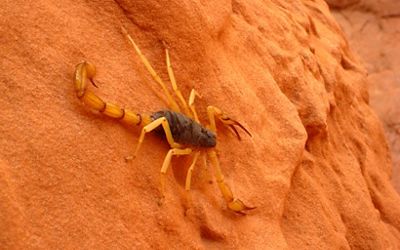
Wyoming's Mule Deer Study
Find out how scientists are studying migration in the Greater Yellowstone ecosystem
Learn moreDesert Burro Dee
ODOCOILEUS HEMIONUS EREMICUS
FAST FACTS
- Found in the Mojave and Sonoran deserts
- Weighs up to 250 lbs.
- Lives 9 to 11 years
- Eats shrubs, grasses and bushes
DID YOU KNOW?
The burro deer is also known as the mule deer. Named for its long ears that resemble a burro’s, this deer hops with all four hooves hitting the ground simultaneously, quickly navigating rough terrain and escaping predators. This trademark running hop is called "stotting." Male deer are recognized by the antlers they grow each summer and fall and shed in the spring. The growth cycle of the antlers is regulated by changes in the length of the days throughout the year. Burro deer keep cool by keeping still during the hottest parts of the day, spending time in beds they make out of flattened grass. These deer also have no upper teeth, just a hard palate at the top of their mouth for grinding the forage they eat.
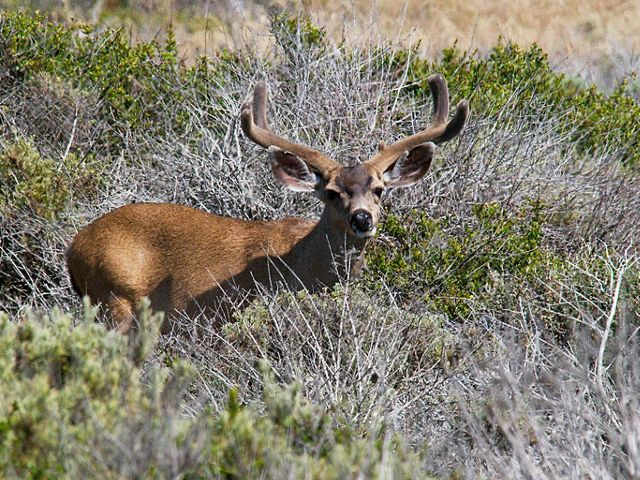
Desert Tortoise
GOPHERUS AGASSIZII
FAST FACTS
- Found in the Mojave Desert
- Lives 50 to 80 years
- Weighs 8 to 15 lbs.
- Eats grasses, cacti and wildflowers
DID YOU KNOW?
Desert tortoise escape the heat and remain hydrated by burrowing into the Mojave’s sun-baked surface, spending up to 98% of their lives underground. They can survive for as long as an entire year without access to water. When they do find water, they can increase their body weight by as much as 40%. They also store water in their bladders like a canteen, which they can reabsorb when necessary. During brief periods of activity, a tortoise will move up to 660 feet in a day. They can survive body temperatures from below freezing to 104 degrees. Their populations have declined about 90% since the 1980s due in large part to habitat loss and fragmentation.
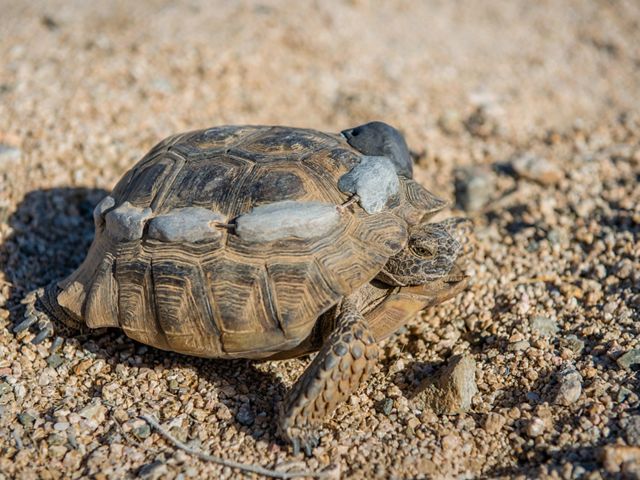
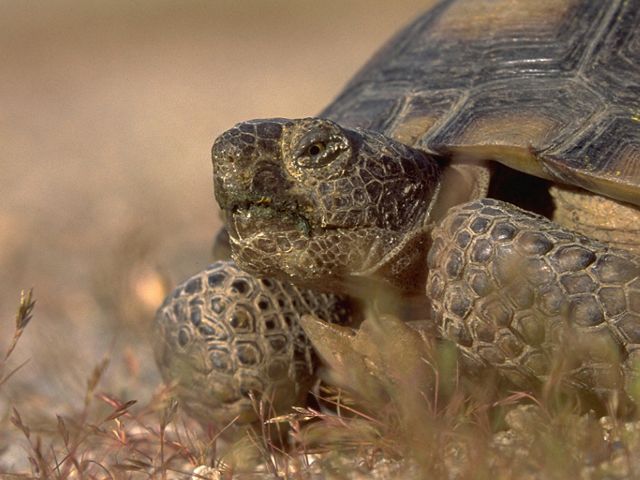
Creosote Bush
LARREA TRIDENTATE
FAST FACTS
- Found in the Mojave and Sonoran deserts
- Blooms fragrant, yellow flowers
- Strengthens wildlife burrows via extensive roots
DID YOU KNOW?
This hardy plant may be among Earth’s oldest living organisms, with individuals carbon dated to nearly 12,000 years ago—and still thriving today. Chemicals found in the creosote bush's roots inhibit the growth of nearby plants, making it easier for the creosote to access the little water that's available. The plant gives off a characteristic odor, associated in some regions where it grows as "the smell of rain." It's small leaves are covered in a waxy coating, which prevents moisture loss in the hot, dry desert climate.
Gila Monster
HELODERMA SUSPECTUM
FAST FACTS
- Found in the Mojave and Sonoran deserts
- Grows up to 2 feet long
- Lives 20 to 30 years
- Eats reptile and bird eggs and small mammals
DID YOU KNOW?
Spending more time underground than even desert tortoises, this slow-moving but venomous lizard climbs trees and cacti to reach food, using an excellent sense of smell to locate prey. Pioneers in the West believed that the Gila monster's venom was fatal, but this theory was disproved when researcher George Goodfellow was bitten while studying a captive Gila monster in 1890. Though not fatal to healthy adults, the venom is a very powerful neurotoxin. Researchers are studying how various chemicals work in Gila monsters' venom, aiming to develop new treatments for a wide range of diseases including lung cancer, Type 2 diabetes and Alzheimer's. The Gila monster became the first venomous animal to gain legal protection, in 1952, after populations declined as a result of habitat loss.

Stay connected for the latest news from nature.
Get global conservation stories, news and local opportunities near you. Check out a sample Nature News email.

















